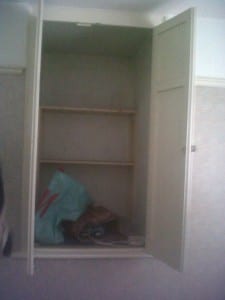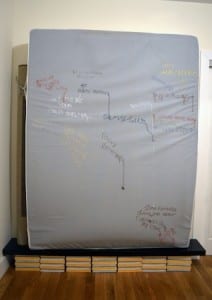My first impressions of the house were that it already had its own atmosphere. My favourite room, though, was the main bedroom for many reasons. It seemed like the most artificial of all the rooms. The décor was as drab as all the others, but the way it was furnished made it look false. The bedding was neatly made, and the bedside table and lamp were in pristine condition. I instantly thought that this room was hiding something. The distinct lack of furniture was unnerving. The room simply consisted of a bed in the centre, a bedside table with a lamp, and a built in cupboard on the wall.
The bedroom is considered a very familiar and secretive space. Cupboards are also renowned for this, “their doors open onto an ever more private realm of intimate things” ((Heathcote, E (2012) The Meaning of Home, London: Frances Lincoln, p 77)). As a visitor in someone’s home you rarely open a cupboard unless instructed to. In my mind, this makes the cupboard in the bedroom twice as private as anywhere else.
There are three main concepts or feelings associated with a cupboard. The obvious one is for storage. Generally, clutter and mess can be hidden neatly away in a cupboard as long as nobody finds it. Secondly, as highlighted so cleverly by Pixar, children often believe that monsters hide in their wardrobes or cupboards. This immediately sparks the emotion of a fear of the unknown. Finally, thanks to C.S Lewis, they can be seen as a place for escapism. All three of these uses can be either portrayed through performance or they can be turned upside down and contradicted.
To portray storage you could simply clutter the wardrobe with either things you wouldn’t associate with a house or very familiar objects.
“Clothes, the contents of the wardrobe are, of course, intimate items” ((Heathcote, E (2012) The Meaning of Home, London: Frances Lincoln, p 78.))
What if we filled it with even more intimate items to make the audience feel uncomfortable or make them feel like they have breached their rights as a visitor?
The escapism aspect could be shown through dreaming. Once the audience member was in the bed the cupboard could be opened. Inside could be filled with dream like objects, fairy lights, tinsel etc. It could also be effective to have a projector inside that projects footage of a dream onto the wall opposite. This would create a huge contrast between the bedroom and the cupboard and highlight the fact that a cupboard is a hiding place for a person, objects or even for thoughts.
The work of Lital Dotan also gave me a lot of inspiration for performance ideas. She uses the technique of installation in her own home. She opens her own bedroom to the public. She lifts her mattress against the wall every day. “The underside reveals a “personal graffiti wall,” covered in loose colorful yarn stitched to form Dotan’s various notes to self:”(Ortiz 2013)
Dotan’s bed / art project (Photo by Emily Wilson) (accessed: 12/02/13) ((Ortiz, Jen (2013) ‘Life as a Glass House’ Narratively, 25 January. http://blackboard.lincoln.ac.uk/webapps/portal/frameset.jsp?tab_tab_group_id=_2_1&url=%2Fwebapps%2Fblackboard%2Fexecute%2Flauncher%3Ftype%3DCourse%26id%3D_67088_1%26url%3D))
This flips the notion of the bedroom being the most private room in the house on its head. Turning it into a form of gallery makes it the most public space. This is an intriguing notion to look at possibly using for a couple of the performance dates.

